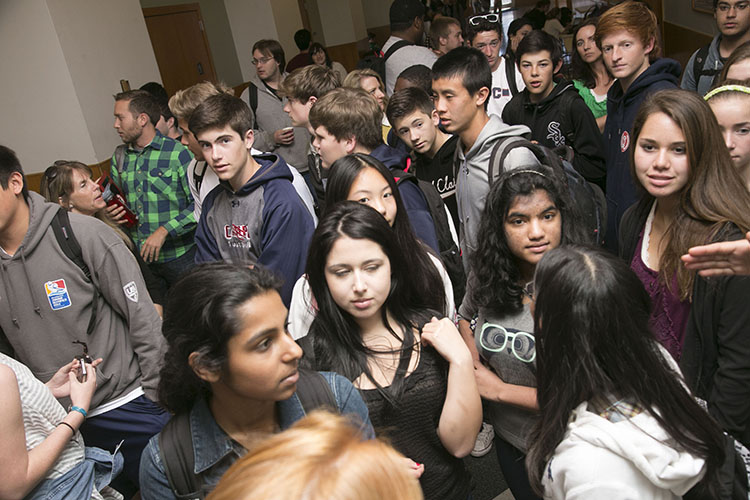District Considers Proposed Transfer Ban
May 7, 2018
Parents, teachers, students and Acalanes High School District administrators convened on March 21 at the district office to discuss a proposed ban on inter-district (from outside the district) transfers starting in the 2019-20 school year.
According to Lamorinda Weekly, as the ban faces further deliberation, admission for inter-district transfers for the 2018-19 school year will continue to be allowed but will be capped at 50 students. The numerical cap, said counselor Amardeep Dhaliwal, will not apply to transfers by children of district employees like teachers. Deliberation will include “consultation with community members,” a “review of alternatives [to the ban],” and a vote on December 7.
More than 3o students spoke at the meeting, all of whose testimonies defended transfers as “scholars, leaders, citizens, and friends” who make our district “stronger” and more “pluralistic.” While Lamorinda Weekly reports that no one at the meeting spoke in the ban’s favor, support for the ban, if covert, has been clear; both the initial proposal of the ban and its continued momentum towards becoming rule speak to an at least equal and opposite base vying for the ban’s implementation.
The ban’s proposal is due to the district’s recent classification as “Basic Aid,” a label that means the cost of accepting inter-district transfers from 2018-19 onward will sit around $1.75-$2.25 million because funding is not distributed per student. Such a cost, said superintendent John Nickerson in Lamorinda Weekly, would create a “tremendous financial burden” on the district.
While opinions on the issue are both personal and nuanced, 2 arguments concerning the proposal prevail. The 1st holds that local taxpayers should not be responsible for financing the education of inter-district transfers from poorer communities at the expense of the academic excellence by which they justify financing their own (expensive) residence in the district. The 2nd holds that the financial burden of allowing transfers is a small price to pay for the economic, racial, and experiential diversity their presence lends our district campuses.
While transfer-ban supporters may deny it, with 58% of last year’s Miramonte transfers identifying as people of color, race is a reality that plays an undeniable role in the question of the ban’s implementation.
Campolindo may enroll a large number of Asian American students, but it represents few other ethnic minorities and supports almost no real socioeconomic diversity. Campolindo currently enrolls 14 African American students; the Black Students Union was founded only just this year.
With other learning environments boasting such variety, some believe Campolindo’s lack of interaction with peers with different racial and situational backgrounds is a disadvantage to students who will experience such diversity in college, at the workplace, and in the real world.
Students recognized the–however hushed–obvious racial flavor of the ban, calling the proposal an “unjust, regressive step” away from promoting equity and engaged, multicultural thought in our schools. Some, like Miramonte senior Zahra Hasanain who spoke at the meeting, understand the transfers as campus assets who lead equity groups and excel both in and beyond the classroom.
Despite considering diversity “extraordinarily valuable,” principal John Walker is unconcerned about the implications the proposed ban may have on the racial and socioeconomic makeup of campus. “I don’t believe it will affect the diversity [of our campus] in any significant way,” said Walker, while conceding that he is “not sure” how it may impact diversity on our neighbor campuses, Miramonte and Acalanes High Schools, because he is “not as familiar with [their] demographics.”
Not surprisingly, the language employed by student opponents of the measure–“ban”–is not that used by campus administration like Walker, who more positively frame the potential action as an increased set of “limitations” on campus enrollment policies.
“It’s not a ban. It’s some school district-wide limits on inter-district transfers,” said Walker, who was quick to highlight that what has been an unfavorable proposal to many is not a Campolindo administration decision but a “governing board decision” in which Campolindo administration has merely played a role.
Campus diversity is not the only associated question that lends relevance to the Campolndo community; more pressing to many is the impact the action may have directly on their family’s education and attendant commute. Many such families have raised their concerns to Walker, who called their arguments, collectively, a vocalization of a “strong desire” to have students enroll at our campus.
“They [the families] have younger students or younger siblings who are interested in being transfers into Campolindo. They have some concern about whether that will or will not be available to them,” said Walker of the concerned raised to him.
Whether moral or personal, resistance to the ban’s proposal is vehement, while support has been more silent; according to Walker, Campolindo administration is yet to have been approached by “anyone advocating for the limitations.” Walker was quick to highlight, however, that the considerable silence of the ban’s proponents may not be an indication of their lack of strength or number. “I just haven’t had someone do that [openly voice support] yet,” said Walker.
No matter one’s side, the proposed increase in transfer limitations is an important and relevant issue to the campus community. “It’s a complicated issue,” said Walker. “There’s a lot of passion associated with it.”

